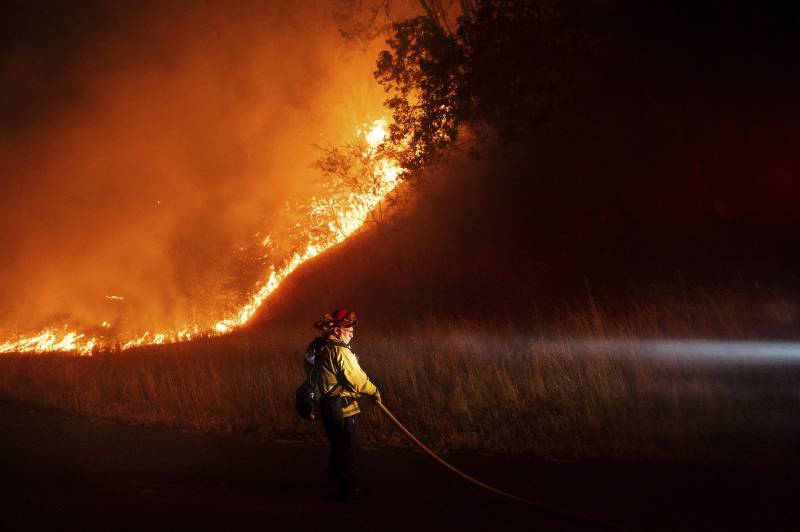The Point Fire, which ignited near Lake Sonoma on Sunday afternoon and has caused orange, smoky skies to descend over much of Napa and Sonoma counties, offers a look at how similar fires could affect Northern California in the coming months.
As it pushed deeper into Sonoma County wine country on Sunday, staff at Quivira Vineyards northeast of Healdsburg were forced to stop production and head into town after fire officials announced an evacuation order.
Before Curtis McCullohs, the owner’s executive assistant, finished loading his truck, he sprayed fire retardant around buildings, storing giant steel tanks of wine and thousands of beverage cases. “That’s a lot of liquid,” he said.
The winery is one of about a dozen within the fire evacuation zone, and staff have yet to be able to check on the vineyard. As of Monday afternoon, McCullohs said the blaze was around three miles from the winery, so he’s not worried that the fire could destroy the 55 acres of grapes around the operation.
But he is nervous about thousands of gallons of chilled wine now cooling off in the winery’s buildings because the power went out around 6 p.m. Sunday. He said the wine could withstand about two more days without additional cooling. If the power remains out, the winery, known for wines like Grenache and Sauvignon Blanc, could suffer a significant blow.
“Even though it’s sealed up, it’ll become ambient temperature,” he said. “Wine can spoil at very high temperatures.”
McCullohs is also worried about another killer of wine that wildfires have on vineyards: smoke taint, which can infuse the aroma of a campfire into grapes, making them virtually unusable for winemaking.
“It’s not technically summer yet, so to have this happening now will continue to bring up the conversation of how weather patterns could be changing and if the winegrowing region might be shifting,” he said. “I think that’s what’s frightening.”
Fires are not uncommon in June in California. The Point Fire and others burning across the state have made it clear that “we are into fire season now,” said Craig Clements, director of the Wildfire Interdisciplinary Research Center at San José State University.
“Even though we’re getting into some slightly bigger fires right now, in general, it should be below normal for most of the summer,” Clements said. “In September and October, that should change. And we should be at higher risk for larger fires.”
Still, he cautioned that fires are a function of day-to-day weather, topography and the condition of vegetation. One extended heat wave could accelerate that timeline, for example.
Dry grass and brush are fueling much of the spread of the Sonoma County fire, which has even ignited oak woodlands and other trees that likely wouldn’t have burned this time of year on their own, Swain said. Winds of 30 to 40 mph drove the mixed vegetation fire south throughout Sunday afternoon before its spread slowed overnight as the wind and heat eased.
As the season progresses, Swain said, similar fires could be more dangerous because temperatures don’t drop as low and relative humidity increases less overnight in autumn.
“This is a different fire than if we had this fire, say, in September or October. The winds are not as strong as they would be, and more importantly, the grass is not as dry as it could be or will be later this season,” Swain said.
Winds in Sonoma County are expected to slow Monday, offering firefighters a chance to increase the Point Fire’s containment, Cal Fire spokesperson Will Powers told KQED.
Swain expects the fire to last for at least another few days. Evacuation orders are still in place for the areas closest to the fire, and the National Weather Service has issued a red flag warning for the North Bay until 8 a.m. Tuesday.


